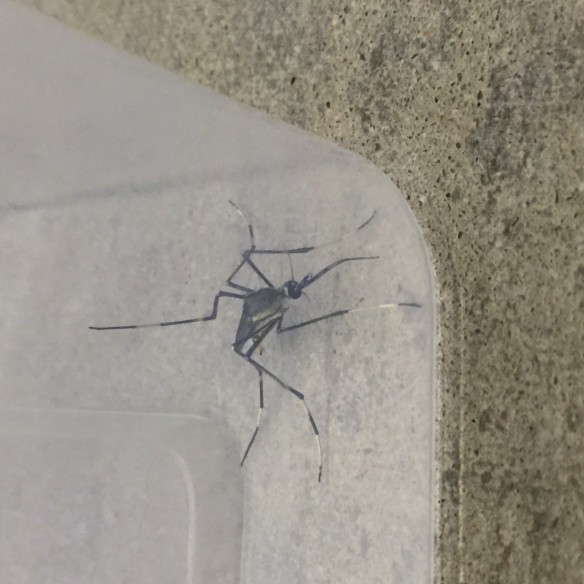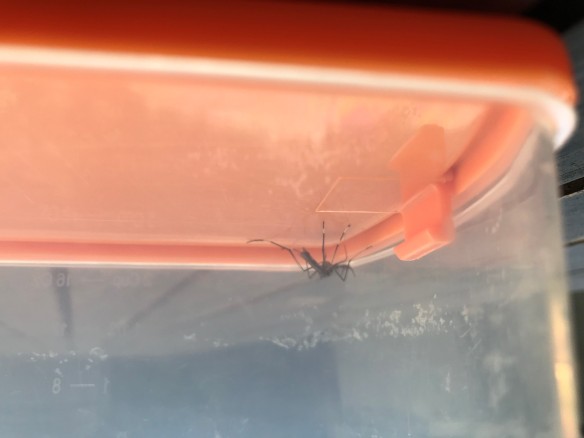
“I’ve never seen anything like it. I actually heard it before I saw it!”
I get more than a dozen emails, tweets, or phone calls every summer like this. Excited (terrified?) correspondence asking about the “giant” mosquito captured in the backyard or buzzing about windows.
Toxorhynchites speciosus is as “good” a mosquito as there can be. First, it is a gorgeous creature. Almost four times the size of a typical mosquito, it is a large dark and shiny mosquito with bright metallic patterns.
There are around 70 species of Toxorhynchites mosquitoes around the world but only a few species found in Australia. The mosquito is reasonably common, but rarely very abundant. It is found along the eastern and north coast of Australia, stretching from Sydney through to Darwin.

The larvae of Toxorhynchites speciosus are large and easily spotted in water-holding containers around the backyard
This is one of the few mosquitoes that don’t need blood. Unlike almost all other mosquitoes, the females of which need blood to develop their eggs, Toxorhynchites speciosus doesn’t bite. It gets its energy from plant juices and nectar.
Even though it doesn’t bite, the sheer size of this mosquito makes it an imposing sight.
They most commonly lay eggs in water holding containers around the home. Pot plant saucers, bird baths, watering cans, buckets, bins and even tree holes and water-filled bromeliads. These are the same types of water-filled containers where you’ll find wrigglers of the pest mosquitoes Aedes notoscriptus and Culex quinquefasciatus.
They have a fascinating way of laying eggs. Unlike many other mosquitoes that elegantly stand on the water surface and lay up to 300 eggs in a neatly packed floating raft, Toxorhynchites lays single eggs. It doesn’t even land on the water to lay eggs, it fires them into water while in mid flight!
Once an appropriate place to deposit an egg has been identified, the mosquito flies in a vertical loop, the loops getting ever smaller until the egg is ejected and into nearby habitats. A neat trick and avoids the risk of being eaten by a hungry spider or other predator waiting by to grab a mosquito coming in to lay eggs.

A specimen of Toxorhynchites speciosus collected by Helen Mamas from the inner west suburb of Sydney, Newtown
Not only do these mosquitoes not bite, they even help out with a little pest mosquito control around the home.
While the mosquito wrigglers of mosquito mosquitoes feed on organic debris floating about in water bodies, the larvae of Toxorhynchites speciosus are predatory and feed on the wrigglers of other mosquitoes. Laboratory studies have shown that a closely related Toxorhnychites consumed over 300 Aedes aegypti (aka the dengue mosquito) larvae during its development. In some parts of the world, a closely related mosquito is used as a biological control agent of the pests that spread dengue, chikungunya and Zika viruses.
While Toxorhynchites speciosus will chomp through plenty of wrigglers of Aedes notoscriptus each summer in Australian backyards, it is unlikely to make a huge difference in bites.
My experience in backyards across Sydney has shown that there is something of a tug-o-war between Toxorhynchites speciosus and other mosquitoes. While undertaking a project with Ku-ring-gai Council looking at backyard mosquitoes and their possible impact on backyard wildlife conservation efforts, I’d often find a fluctuating dynamic between the mosquito predators and their prey. Populations of Aedes notoscriptus or Culex quinquefasciatus would build up in bird baths and buckets, then Toxorhynchites speciosus would move in. They’re eat through all the other larvae, then once emerged and flown off, the other mosquitoes would move back in. And the cycle continued.

Image of Toxorhynchites speciosus sent to be by David Lawson from the inner west suburbs of Marrickville, Sydney.
Next time you see a “giant mozzie” buzz by, think twice before you squish it. Oh, and keep in mind that this mosquito is also a movie star! Do you recognise it from Jurassic Park?
If you want to keep the pest mosquitoes out of your backyard, make sure you get rid of any water-holding containers. If you can’t throw them out, keep them covered.
Check to make sure your roof gutters and drains are clear of leaves and other debris so they flow freely. Check your rainwater tank is screened to stop the mozzies entering. And try not to kill the good guys who help keep the other mozzies at bay!
For more on how to better control insect pests in and around the home, read one of our latest publications on engaging urban stakeholders in the sustainable management of arthropod pests.
Find out more about Australia’s fascinating mosquitoes by checking out our “A Guide to Mosquitoes of Australia” via CSIRO Publishing!



